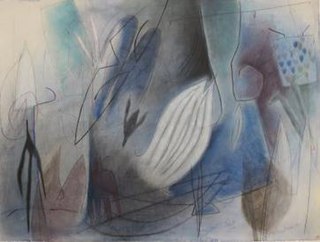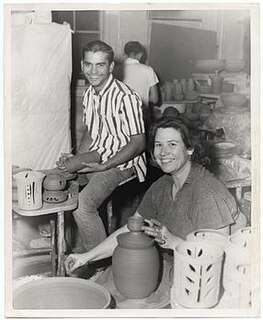Related Research Articles
Michael Max Asher was a conceptual artist, described by The New York Times as "among the patron saints of the Conceptual Art phylum known as Institutional Critique, an often esoteric dissection of the assumptions that govern how we perceive art." Rather than designing new art objects, Asher typically altered the existing environment, by repositioning or removing artworks, walls, facades, etc.

Little Tokyo also known as Little Tokyo Historic District, is an ethnically Japanese American district in downtown Los Angeles and the heart of the largest Japanese-American population in North America. It is the largest and most populous of only three official Japantowns in the United States, all of which are in California. Founded around the beginning of the 20th century, the area, sometimes called Lil' Tokyo, J-Town, 小東京 (Shō-tōkyō), is the cultural center for Japanese Americans in Southern California. It was declared a National Historic Landmark District in 1995.
The J. Paul Getty Trust is one of the world's wealthiest art institutions with an estimated endowment in 2017 of $US 6.9 billion. Based in Los Angeles, California, it operates the J. Paul Getty Museum, which has two locations, the Getty Center in Los Angeles and the Getty Villa in Pacific Palisades district of Los Angeles, California. Its other programs are the Getty Foundation, the Getty Research Institute, and the Getty Conservation Institute.

Emmi Whitehorse is a Native American painter and printmaker. She was born in Crownpoint, New Mexico and is a member of the Navajo Nation. She lives in Santa Fe, New Mexico and grew up on the open land northeast of Gallup, New Mexico in a family where only the Navajo Language was spoken.
Millard Owen Sheets was an American artist, teacher, and architectural designer. He was one of the earliest of the California Scene Painting artists and helped define the art movement. Many of his large-scale building-mounted mosaics from the mid-20th century are still extant in Southern California.
Samella Sanders Lewis is an African-American artist, working primarily as a printmaker and painter. She is also a published author, art historian and a former educator.
Judy Fiskin is an American artist working in photography and video, and a member of the art school faculty at California Institute of the Arts. Her videos have been screened in the Documentary Fortnight series at the Museum of Modern Art in New York, at the Los Angeles County Museum of Art, the Hammer Museum in Los Angeles, and at the J. Paul Getty Museum in Los Angeles; her photographs have been shown at MOCA, the Museum of Contemporary Art in Los Angeles, at the Getty Museum in Los Angeles, at The New Museum in New York City, and at the Pompidou Center in Paris.

Ralph Bacerra was a ceramic artist and career educator. He lived and worked in Los Angeles, California.
Peter Shelton is an American sculptor born in 1951 in Troy, Ohio.
Barbara Turner Smith is an American artist known for her performance art in the late 1960s, exploring themes of food, nurturing, the body, spirituality, and sexuality. Smith was part of the Feminist Movement in Southern California in the 1970s, and has collaborated in her work with scientists and other artists. Her work has been widely exhibited and collected by major museums including the J. Paul Getty Museum, the Hammer Museum, MOCA, LACMA, and the Art Institute of Chicago.
Howard Fried is an American conceptual artist who became known in the 1970s for his pioneering work in video art, performance art, and installation art.
Pacific Standard Time: Art in L.A., 1945–1980 was a scholarly initiative funded by the J. Paul Getty Trust to historicize the contributions to contemporary art history of artists, curators, critics, and others based in Los Angeles. Planned for nearly a decade, PST, as it was called, granted nearly 60 organizations throughout Southern California a total of $10 million to produce exhibitions that explored the years between 1945 and 1980. Underscoring the significance of this project, art critic Roberta Smith wrote in The New York Times:
Before [PST], we knew a lot [about the history of contemporary art], and that lot tended to greatly favor New York. A few Los Angeles artists were highly visible and unanimously revered, namely Ed Ruscha and other denizens of the Ferus Gallery, that supercool locus of the Los Angeles art scene in the 1960s, plus Bruce Nauman and Chris Burden, but that was about it. After, we know a whole lot more, and the balance is much more even. One of the many messages delivered by this profusion of what will eventually be nearly 70 museum exhibitions is that New York did not act alone in the postwar era. And neither did those fabulous Ferus boys.
Helen Pashgian is an American visual artist who lives and works in Pasadena, California. She is a primary member of the Light and Space art movement of the 1960s, but her role has been historically under-recognized.
Ronald Yoshiaki Miyashiro is an important Japanese American painter, jewelry maker and assemblage artist. Miyashiro, who was born in Honolulu, Hawaii, first came to prominence in 1961 while still a student at Chouinard Art Institute in Los Angeles, when he appeared on the controversial poster for "War Babies," an influential exhibition at Henry Hopkins' Huysman Gallery in Los Angeles, along with his friends and contemporaries Larry Bell, Ed Bereal, and Joe Goode. Miyashiro later moved from Los Angeles to New York City where he continues to make work in multiple media. His early work has enjoyed a resurgence in recent years, and has been included in a number of high-profile museum exhibitions devoted to art from the 1960s.
Betty Asher was an American art collector and dealer. An ardent supporter of Pop art and Contemporary art, her large collection of cups and saucers by artists was world-famous.
Charles Gaines is an American artist whose work interrogates the discourse of aesthetics, politics, and philosophy. Taking the form of drawings, photographic series and video installations, the work consistently involves the use of systems, predominantly in the form of the grid, often in combination with photography. His work is rooted in Conceptual Art – in dialogue with artists such as Sol LeWitt, Lawrence Weiner and Mel Bochner – and Gaines is committed to its tenets of engaging cognition and language. As one of the only African-American conceptual artists working in the 1970s, a time when political expressionism was a prevailing concern among African-American artists, Gaines was an outlier in his pursuit of abstraction and non-didactic approach to race and politics. There is a strong musical thread running through much of Gaines' work, evident in his repeated use of musical scores as well in his engagement with the idea of indeterminacy, as similar to John Cage.
Helene Winer is an American art gallery owner and curator. She co-owns Metro Pictures Gallery in New York City with Janelle Reiring. Her career deeply involved the postmodern artists of the 1970s and 1980s known as the Pictures Generation.
William Hemmerdinger is an American artist, gallery owner, critic, and educator. For most of his artistic career he lived and worked in Los Angeles. He now teaches at the Boston Architectural college.
Wendy Maruyama is an artist, furniture maker, and educator from California. She was born in La Junta, Colorado.
Rena Small is an American conceptual artist who works primarily in photography. Small is best known for her ongoing series The Artists' Hands Continuum, consisting of black and white photographs of the hands of well-known artists. She began the project in 1994.
References
- ↑ "Hirokazu Kosaka artist". New West Symphony. Retrieved 2020-12-15.
- ↑ Fallon, Michael (2014-08-18). Creating the Future: Art and Los Angeles in the 1970s. Counterpoint. ISBN 978-1-61902-404-5.
- ↑ Rosenberg, Jeremy (2012-03-15). "Hirokazu Kosaka: From a Buddhist Monastery in Japan to an Art Legend". KCET. Retrieved 2020-11-21.
- ↑ "Hirokazu Kosaka: On The Verandah Selected Works 1969-1974 | Pomona Museum". www.pomona.edu. Retrieved 2020-11-22.
- ↑ "Artist: Hirokazu Kosaka". www.metro.net. Retrieved 2020-11-21.
- ↑ Communications, Emmis (April 2004). Indianapolis Monthly. Emmis Communications.
- ↑ "Hirokazu Kosaka". Creative Capital. Retrieved 2020-11-21.
- ↑ "United States Artists » Hirokazu Kosaka" . Retrieved 2020-11-21.
- ↑ "Hirokazu Kosaka: On The Verandah Selected Works 1969-1974 | Pomona Museum". www.pomona.edu. Retrieved 2020-11-21.
- ↑ "Kalpa". www.getty.edu. Retrieved 2020-11-21.
- ↑ "Hirokazu Kosaka: In the Mood". www.moca.org. Retrieved 2020-11-21.